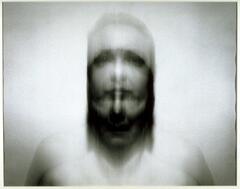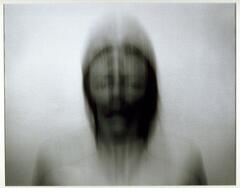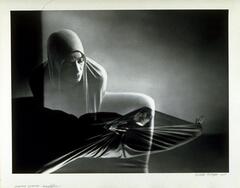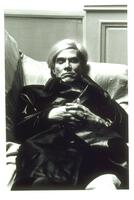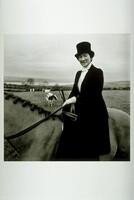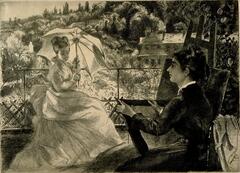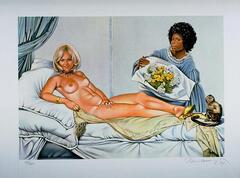12 Items in this Learning Collection
Collection Object
Collection Object
Collection Object
Collection Object
Collection Object
Collection Object
Collection Object
Collection Object
Resource with 5 media
Collection Object
Collection Object
Collection Object
Copyright
All Rights Reserved
()
Birmingham Race Riot
Accession Number
1986/1.194.5
Title
Birmingham Race Riot
Artist(s)
Andy Warhol
Artist Nationality
American (North American)
Object Creation Date
1964
Medium & Support
screenprint on paper
Dimensions
20 1/16 in x 24 1/16 in (50.96 cm x 61.12 cm);26 1/8 in x 32 1/16 in (66.36 cm x 81.44 cm)
Credit Line
Gift of Graham and Marianne Smith
Label copy
In the early 1960s Andy Warhol turned to themes of grisly catastrophe culled from newspapers and magazines, beginning with the painting "129 Die in Jet (Plane Crash)" taken from the cover of the June 4, 1962 "New York Mirror." In 1963 he began in earnest to focus on images of conflict and death in works that have collectively come to be known as his Disaster Series. Although Warhol never avowed any political connections, several works in this body of images evidence a strong reaction to social and political issues of the times form civil rights to the death penalty.
In contrast to his works on canvas, which often incorporated repeated images, Warhol typically depicted only a single photogrpahic image in his early works on paper, isolating and compounding the tension between the artwork and its media source. The single image is starker and more confrontational than the decorative, often numbing effects created by repetition. Also, as in most of his early prints, Warhol used black ink against white paper, again recalling its photogrpahic source, whereas color plays a critical role in the expressive qualities of painted versions.
For the "Race Riot" imges, Warhol made screens form three photographs he found in a 1963 "Life" magazine series by Charles Moore showing the brutal police confrontation with protesters during the Birmingham, Alabama, civil rights riots.1 In 1963 and 1964, Warhol based several paintings and a series of unique images on paper on these photographs, as he had done with the "Cagney" and "Suicide" in 1962.2 For the editioned print in 1964, titled "Birmingham Race Riot," he reversed and cropped one of the photographs, focusing on a central detail. This close-up ironically makes the crowded scene more difficult to decipher as figures are abruptly cut off. The truncated image engenders a narrative, cinematic impulse as the viewer expects the image to be completed in the next frame.3 The high-contrast black-and-white contributes to an optically dizzying effect, and the off-register printing exaggerates the illegibility, adding an urgent, frantic dynamic.
Warhol's artful manipulation of this photojournalistic image heightens its disturbing, frenzied qualities and offers evidence of Warhol's reaction to an issue of civil strife that came to define the 1960s in America. The work's printer, George Townsend of Sirocco Screenprinters, clearly remembers Warhol's intent with this image. Warhol called this eposide a "blot on the American conscience" and asked Townsend for a muddier printing.4
1. The photographs appeared in the May 17, 1963 issue. The segregationist police commissioner Bull Conner unleashed attack dogs and fire hoses on a nonviolent demonstartion by school-children and freedom fighters led by Martin Luther King, Jr. The Birmingham policce clubbed the crowd in front of television adn newspaper cameras.
2. For works on canvas see "Red Race Riot" and "Mustard Race Riot," 1963, and "Little Race Riot," 1964.
3. Warhol's cropping in "Cagney" achieves very different effects. See p. 41 [of "Pop Impressions Europe/USA].
4. Townsend, conversation with the author, August 1998.
--from Wendy Weitman, "Pop Impressions Europe/USA: Prints and Multiples from the Museum of Modern Art," 1999, distributed by Harry N. Abrams, Inc., New York, p. 90.
-------------------------
6/28/10
Andy Warhol (United States, 1928–1987)
Birmingham Race Riot
1964
Screenprint on paper
Gift of Graham and Marianne Smith
In the early 1960s Andy Warhol produced a series of works based on scenes of death and disaster culled from the pages of newspapers and magazines. Warhol’s works on canvas from this series often involved the serial repetition of the same image. When working on paper, however, Warhol tended to restrict himself to a single photographic image, highlighting the tension between the artwork and its media source.
For his 1963–4 Race Riot series, Warhol worked from three LIFE magazine photographs documenting a brutal police confrontation with protesters during the 1963 Birmingham, Alabama civil rights riots. For this print, he reversed and cropped one of the photographs, focusing on a central detail of police unleashing attack dogs on a protestor. This act of cropping endows the image with a quasi-cinematic effect, as if the action will continue in a subsequent frame. At the same time, Warhol’s high-contrast, off-register printing exaggerates the illegibility of the purportedly documentary image.
Various Artists
Ten Works x Ten Painters
1964
Gift of Graham and Marianne Smith
George Ortman (born 1926)
Untitled
Screenprint on paper
1986/1.194.1
Frank Stella (born 1936)
Untitled
Screenprint on paper
1986/1.194.2
Ellsworth Kelly (born 1923)
Untitled
Screenprint on paper
1986/1.194.3
Robert Motherwell (1915–1991)
Untitled
Screenprint and collage on paper
1986/1.194.4
Andy Warhol (1928–1987)
Birmingham Race Riot
Screenprint on paper
1986/1.194.5
Stuart Davis (1894–1964)
Untitled
Screenprint on paper
1986/1.194.6
Roy Lichtenstein (1923–1997)
Sandwich and Soda
Screenprint on mylar
1986/1.194.7
Larry Poons (born 1937)
Untitled
Screenprint on paper
1986/1.194.8
Robert Indiana (born 1928)
External Hexagon
Screenprint on paper
1986/1.194.9
Ad Reinhardt (1913–1967)
Untitled
Screenprint on paper
1986/1.194.10
In the early 1960s there was a widespread printmaking revival in the United States. During this time numerous studios and workshops were established on the East and West Coasts, including Tamarind Workshop, Universal Limited Art Editions, Gemini G.E.L., and Crown Point Press. This revitalization of printmaking coincided with the rise of Pop art and Minimalism, two modern art movements that shared with printmaking an interest in modern technology, reproducibility, and mass production. Further support was generated by newly formed professional organizations and publications devoted solely to the medium and art of printmaking. Galleries and museums began to acquire, exhibit, and commission limited edition prints and print portfolios. One particularly popular strategy was to publish the work of several artists together. Ten Works x Ten Painters is one of the earliest examples of this type of portfolio and is especially notable because it was the first to be published by a museum. Samuel J. Wagstaff, the curator of paintings at the Wadsworth Atheneum in Hartford, Connecticut, who commissioned the portfolio, wanted to make work by major American artists accessible to a wider audience and range of collectors. Many of the ten prints express a Pop sensibility, either in subject or color choice, but the selection of artists was still diverse. Each of the prints was based on a painting the artists had previously created, and for Wagstaff, the unifying bond among the prints was their flatness and the ease in which the painting was translated to ink on paper.
All of the works in the portfolio—printed by Norman Ives and Sewell Sillman at Sirocco Screenprints in New Haven, Connecticut—were silkscreen prints on paper with the exception of two: the Lichtenstein, which was printed on mylar, and the Motherwell, which had additional paper collage elements. In both cases, it was the first time the artist had employed these techniques.
(6/28/10)
Subject matter
The Birmingham Riots took place in May of 1963. There are many similar photographs and images from the Civil Rights Era of the confrontation between protestors and police officers who often attacked (often peaceful) protestors with police dogs, weapons, and fire hoses. The images Warhol looked at were from a 1963 "Life" magazine series by Charles Moore. He reversed and cropped one of the photographs for the composition of this print.
This work is one of ten prints published within a portfolio, “Ten Works + Ten Painters”, commissioned by Samuel J. Wagstaff from the Wadsworth Atheneum Museum in 1964. This portfolio was one of the earliest to have several artists published together to make major American artists accessible to a wider audience and range of collectors. Each print in this portfolio was based on a painting the artists had previously created. Some of the artists represented, in addition to Andy Warhol, are Frank Stella, Robert Motherwell, Ellsworth Kelly and Roy Lichtenstein who were associated with the Pop and Minimalism art movements in the 1960s.
Physical Description
This work shows a black and white photograph of a crowd of people outdoors, with trees in the background. On the left is a uniformed policeman holding a dog on a leash in one hand and a club in the other. In the center area there is a man, with his back to the viewer, who is being attacked by two dogs. One, controlled by another policeman, is ripping his clothing and the other, with teeth bared, is attacking his right hand. In the crowd there are men watching the attack and looking at the policemen.
Primary Object Classification
Print
Primary Object Type
black and white print
Collection Area
Photography
Rights
If you are interested in using an image for a publication, please visit http://umma.umich.edu/request-image for more information and to fill out the online Image Rights and Reproductions Request Form. Keywords
African American
Figures
children (people by age group)
civil rights
dogs
groups
groups of people
modern and contemporary art
nightsticks
police officers
political art
standing
trees
walking
1986/1.194.5
Title
Birmingham Race Riot
Artist(s)
Andy Warhol
Artist Nationality
American (North American)
Object Creation Date
1964
Medium & Support
screenprint on paper
Dimensions
20 1/16 in x 24 1/16 in (50.96 cm x 61.12 cm);26 1/8 in x 32 1/16 in (66.36 cm x 81.44 cm)
Credit Line
Gift of Graham and Marianne Smith
Label copy
In the early 1960s Andy Warhol turned to themes of grisly catastrophe culled from newspapers and magazines, beginning with the painting "129 Die in Jet (Plane Crash)" taken from the cover of the June 4, 1962 "New York Mirror." In 1963 he began in earnest to focus on images of conflict and death in works that have collectively come to be known as his Disaster Series. Although Warhol never avowed any political connections, several works in this body of images evidence a strong reaction to social and political issues of the times form civil rights to the death penalty.
In contrast to his works on canvas, which often incorporated repeated images, Warhol typically depicted only a single photogrpahic image in his early works on paper, isolating and compounding the tension between the artwork and its media source. The single image is starker and more confrontational than the decorative, often numbing effects created by repetition. Also, as in most of his early prints, Warhol used black ink against white paper, again recalling its photogrpahic source, whereas color plays a critical role in the expressive qualities of painted versions.
For the "Race Riot" imges, Warhol made screens form three photographs he found in a 1963 "Life" magazine series by Charles Moore showing the brutal police confrontation with protesters during the Birmingham, Alabama, civil rights riots.1 In 1963 and 1964, Warhol based several paintings and a series of unique images on paper on these photographs, as he had done with the "Cagney" and "Suicide" in 1962.2 For the editioned print in 1964, titled "Birmingham Race Riot," he reversed and cropped one of the photographs, focusing on a central detail. This close-up ironically makes the crowded scene more difficult to decipher as figures are abruptly cut off. The truncated image engenders a narrative, cinematic impulse as the viewer expects the image to be completed in the next frame.3 The high-contrast black-and-white contributes to an optically dizzying effect, and the off-register printing exaggerates the illegibility, adding an urgent, frantic dynamic.
Warhol's artful manipulation of this photojournalistic image heightens its disturbing, frenzied qualities and offers evidence of Warhol's reaction to an issue of civil strife that came to define the 1960s in America. The work's printer, George Townsend of Sirocco Screenprinters, clearly remembers Warhol's intent with this image. Warhol called this eposide a "blot on the American conscience" and asked Townsend for a muddier printing.4
1. The photographs appeared in the May 17, 1963 issue. The segregationist police commissioner Bull Conner unleashed attack dogs and fire hoses on a nonviolent demonstartion by school-children and freedom fighters led by Martin Luther King, Jr. The Birmingham policce clubbed the crowd in front of television adn newspaper cameras.
2. For works on canvas see "Red Race Riot" and "Mustard Race Riot," 1963, and "Little Race Riot," 1964.
3. Warhol's cropping in "Cagney" achieves very different effects. See p. 41 [of "Pop Impressions Europe/USA].
4. Townsend, conversation with the author, August 1998.
--from Wendy Weitman, "Pop Impressions Europe/USA: Prints and Multiples from the Museum of Modern Art," 1999, distributed by Harry N. Abrams, Inc., New York, p. 90.
-------------------------
6/28/10
Andy Warhol (United States, 1928–1987)
Birmingham Race Riot
1964
Screenprint on paper
Gift of Graham and Marianne Smith
In the early 1960s Andy Warhol produced a series of works based on scenes of death and disaster culled from the pages of newspapers and magazines. Warhol’s works on canvas from this series often involved the serial repetition of the same image. When working on paper, however, Warhol tended to restrict himself to a single photographic image, highlighting the tension between the artwork and its media source.
For his 1963–4 Race Riot series, Warhol worked from three LIFE magazine photographs documenting a brutal police confrontation with protesters during the 1963 Birmingham, Alabama civil rights riots. For this print, he reversed and cropped one of the photographs, focusing on a central detail of police unleashing attack dogs on a protestor. This act of cropping endows the image with a quasi-cinematic effect, as if the action will continue in a subsequent frame. At the same time, Warhol’s high-contrast, off-register printing exaggerates the illegibility of the purportedly documentary image.
Various Artists
Ten Works x Ten Painters
1964
Gift of Graham and Marianne Smith
George Ortman (born 1926)
Untitled
Screenprint on paper
1986/1.194.1
Frank Stella (born 1936)
Untitled
Screenprint on paper
1986/1.194.2
Ellsworth Kelly (born 1923)
Untitled
Screenprint on paper
1986/1.194.3
Robert Motherwell (1915–1991)
Untitled
Screenprint and collage on paper
1986/1.194.4
Andy Warhol (1928–1987)
Birmingham Race Riot
Screenprint on paper
1986/1.194.5
Stuart Davis (1894–1964)
Untitled
Screenprint on paper
1986/1.194.6
Roy Lichtenstein (1923–1997)
Sandwich and Soda
Screenprint on mylar
1986/1.194.7
Larry Poons (born 1937)
Untitled
Screenprint on paper
1986/1.194.8
Robert Indiana (born 1928)
External Hexagon
Screenprint on paper
1986/1.194.9
Ad Reinhardt (1913–1967)
Untitled
Screenprint on paper
1986/1.194.10
In the early 1960s there was a widespread printmaking revival in the United States. During this time numerous studios and workshops were established on the East and West Coasts, including Tamarind Workshop, Universal Limited Art Editions, Gemini G.E.L., and Crown Point Press. This revitalization of printmaking coincided with the rise of Pop art and Minimalism, two modern art movements that shared with printmaking an interest in modern technology, reproducibility, and mass production. Further support was generated by newly formed professional organizations and publications devoted solely to the medium and art of printmaking. Galleries and museums began to acquire, exhibit, and commission limited edition prints and print portfolios. One particularly popular strategy was to publish the work of several artists together. Ten Works x Ten Painters is one of the earliest examples of this type of portfolio and is especially notable because it was the first to be published by a museum. Samuel J. Wagstaff, the curator of paintings at the Wadsworth Atheneum in Hartford, Connecticut, who commissioned the portfolio, wanted to make work by major American artists accessible to a wider audience and range of collectors. Many of the ten prints express a Pop sensibility, either in subject or color choice, but the selection of artists was still diverse. Each of the prints was based on a painting the artists had previously created, and for Wagstaff, the unifying bond among the prints was their flatness and the ease in which the painting was translated to ink on paper.
All of the works in the portfolio—printed by Norman Ives and Sewell Sillman at Sirocco Screenprints in New Haven, Connecticut—were silkscreen prints on paper with the exception of two: the Lichtenstein, which was printed on mylar, and the Motherwell, which had additional paper collage elements. In both cases, it was the first time the artist had employed these techniques.
(6/28/10)
Subject matter
The Birmingham Riots took place in May of 1963. There are many similar photographs and images from the Civil Rights Era of the confrontation between protestors and police officers who often attacked (often peaceful) protestors with police dogs, weapons, and fire hoses. The images Warhol looked at were from a 1963 "Life" magazine series by Charles Moore. He reversed and cropped one of the photographs for the composition of this print.
This work is one of ten prints published within a portfolio, “Ten Works + Ten Painters”, commissioned by Samuel J. Wagstaff from the Wadsworth Atheneum Museum in 1964. This portfolio was one of the earliest to have several artists published together to make major American artists accessible to a wider audience and range of collectors. Each print in this portfolio was based on a painting the artists had previously created. Some of the artists represented, in addition to Andy Warhol, are Frank Stella, Robert Motherwell, Ellsworth Kelly and Roy Lichtenstein who were associated with the Pop and Minimalism art movements in the 1960s.
Physical Description
This work shows a black and white photograph of a crowd of people outdoors, with trees in the background. On the left is a uniformed policeman holding a dog on a leash in one hand and a club in the other. In the center area there is a man, with his back to the viewer, who is being attacked by two dogs. One, controlled by another policeman, is ripping his clothing and the other, with teeth bared, is attacking his right hand. In the crowd there are men watching the attack and looking at the policemen.
Primary Object Classification
Primary Object Type
black and white print
Collection Area
Photography
Rights
If you are interested in using an image for a publication, please visit http://umma.umich.edu/request-image for more information and to fill out the online Image Rights and Reproductions Request Form. Keywords
African American
Figures
children (people by age group)
civil rights
dogs
groups
groups of people
modern and contemporary art
nightsticks
police officers
political art
standing
trees
walking
